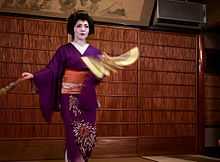Buyō

Buyō (舞踊) or Nippon buyō/Nihon buyō (日本舞踊) is a traditional Japanese performing art, a mixture of dance and pantomime, which emerged in the early Edo period (early 17th century) from earlier traditions. While performed independently by specialists, it is particularly conspicuous as the style of dancing performed by geisha.
Influences
Nihon buyō differs from other Japanese traditional dances in that it is intended for entertainment on stage.[1] Nihon buyō is a refined dance that has been improved throughout four centuries.[1] There are four influences on Nihon buyō, the most significant being kabuki buyō.[1] Nihon buyō was created directly from kabuki buyō before it became theater. The second influence on Nihon buyō is noh.[1] Nihon buyō takes a few key elements from noh such as the circular movements and the tools used in its dances. The third influence on these dances comes from folk dances; the spinning and jumping used in folk dances was incorporated into Nihon buyō. The last influence comes from the mixture of European and American culture that is found in Japan today.[1]
Sparrow dance
The sparrow dance (雀踊り suzume odori) is a dance based on the fluttering movements of the Eurasian tree sparrow.[2] It was first performed, improvised, by stonemasons who were constructing Sendai Castle for the daimyo Date Masamune. The emblem of the Date clan incorporates two tree sparrows. The sparrow dance is now performed yearly in Sendai, Miyagi prefecture at the Aoba festival in mid-May.[2] School children in Miyagi prefecture learn and perform the sparrow dance, especially during the Obon Festival.
References
- ↑ 1.0 1.1 1.2 1.3 1.4 The Japanese Classical Dance Association Inc.|What is nihon buyo?. Nihonbuyou.or.jp. Retrieved on 2012-03-13.
- ↑ 2.0 2.1 Sendai Suzume Odori (Sendai Sparrow Dance ). Aoba-matsuri.com. Retrieved on 2012-03-13.
External links
Japanese classical dance
- The Japanese Dance Association, Inc "What is nihon buyo?"
- Nihon Buyo Foundation
- Nihon Buyo delights UK Audiences - May 16, 2005
- Tachibana School of Nihon Buyo